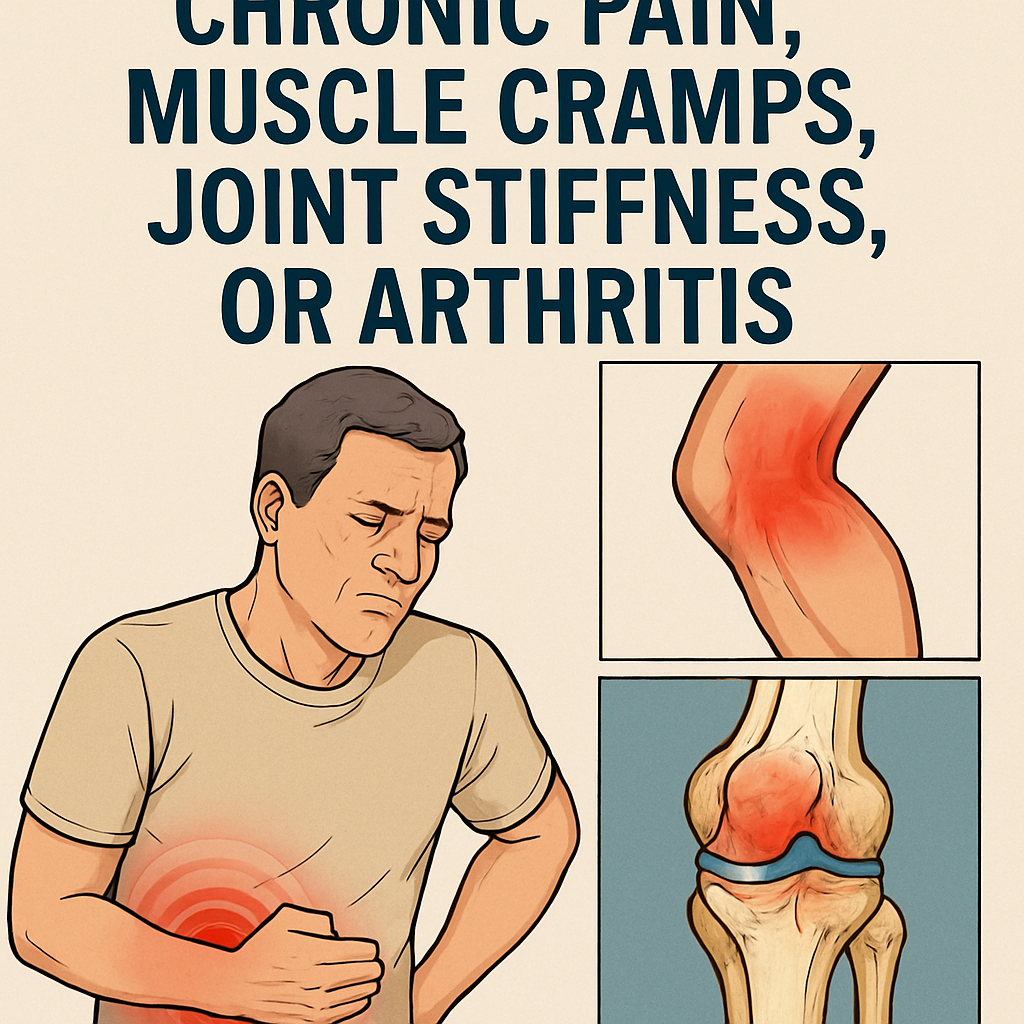
Understanding the Root Causes of Chronic Pain and Joint Discomfort
Chronic pain, muscle cramps, joint stiffness, and arthritis are often interconnected conditions that severely impact quality of life. At their core, these issues are typically the result of systemic inflammation, autoimmune responses, wear and tear of cartilage, muscle overuse, mineral deficiencies, and poor circulation.
Chronic pain is often neuropathic or inflammatory in nature. Persistent activation of pain receptors in the central or peripheral nervous system leads to prolonged discomfort. Joint stiffness usually results from reduced synovial fluid, calcification, or fibrosis in connective tissue, while arthritis—particularly osteoarthritis and rheumatoid arthritis—triggers progressive cartilage degeneration or autoimmune attacks on the joints.
Nutrition-Based Approaches for Reducing Inflammation and Cramping
Anti-Inflammatory Diet
A nutrient-dense, anti-inflammatory diet is foundational in reversing chronic pain and joint degradation. We emphasize:
- Omega-3 fatty acids (found in wild salmon, flaxseeds, walnuts) to counteract joint inflammation
- Leafy greens (like spinach and kale), rich in vitamin K and antioxidants, to support bone and cartilage health
- Bone broth and collagen peptides to promote joint tissue repair
- Low-glycemic fruits such as berries to prevent blood sugar spikes that trigger inflammatory pathways
Magnesium, Potassium, and Calcium
Deficiencies in magnesium, potassium, or calcium often contribute to muscle cramps and nerve excitability. Incorporating:
- Avocados, bananas, pumpkin seeds, and almonds for magnesium and potassium
- Sardines, leafy greens, and fortified plant milks for calcium
can reduce cramping and enhance neuromuscular coordination.
Targeted Physical Therapy for Joint Mobility and Muscle Relaxation
Custom physical therapy regimens dramatically improve joint flexibility, reduce stiffness, and correct muscular imbalances. We recommend:
- Isometric exercises for joint support without excessive strain
- Dynamic stretching routines that increase range of motion and reduce stiffness
- Foam rolling and myofascial release for tight muscle groups and trigger points
- Tai Chi and Yoga for promoting neuromuscular harmony and joint alignment
For arthritis sufferers, aqua therapy and non-weight-bearing exercises like cycling can preserve mobility while minimizing joint stress.
Advanced Supplementation for Pain and Joint Health
A synergistic stack of evidence-based supplements may support connective tissue regeneration and reduce pain perception:
- Glucosamine and Chondroitin Sulfate: Encourage cartilage repair and inhibit enzymes that break down joint tissue
- MSM (Methylsulfonylmethane): Potent anti-inflammatory that improves joint flexibility
- Turmeric (Curcumin): Blocks inflammatory cytokines and reduces stiffness
- Boswellia Serrata: Inhibits 5-lipoxygenase and relieves pain in osteoarthritic joints
- Vitamin D3 + K2: Enhances calcium metabolism and bone integrity
Combining these with high-potency B-complex vitamins supports nerve regeneration and reduces neuropathic pain.
Sleep Optimization and Chronic Pain Reduction
Sleep deprivation amplifies pain sensitivity and reduces tissue recovery. To enhance restorative sleep:
- Maintain a cool, dark environment to stimulate melatonin production
- Avoid screens and blue light at least one hour before bed
- Supplement with magnesium glycinate, L-theanine, or CBD to promote deep, uninterrupted sleep
Prioritizing sleep accelerates healing, hormonal balance, and inflammatory control.
Heat and Cold Therapy to Reduce Muscle Cramps and Inflammation
Alternating between heat and cold therapy yields rapid relief:
- Heat packs improve blood flow, reduce stiffness, and relax tight muscles
- Ice therapy lowers inflammation and numbs nerve endings to dull pain
- Contrast baths (alternating hot and cold water immersions) flush toxins and enhance tissue oxygenation
These methods are especially effective when paired with stretching or massage therapy.
Mind-Body Integration for Long-Term Pain Control
Chronic pain often involves psychosomatic elements. Integrating mental health strategies with physical interventions delivers longer-lasting relief:
- Mindfulness meditation helps in pain reframing and reduces stress-induced tension
- Breathwork techniques improve parasympathetic activation, reducing muscle tone and stiffness
- Cognitive behavioral therapy (CBT) aids in detaching negative thought loops linked with chronic pain
Conclusion: A Holistic Framework for Joint and Muscle Wellness
To combat chronic pain, muscle cramps, joint stiffness, and arthritis, we advocate a multidimensional strategy—combining anti-inflammatory nutrition, targeted movement, scientific supplementation, sleep regulation, and mind-body awareness. This approach not only alleviates symptoms but also restores long-term musculoskeletal health, resilience, and functional vitality.